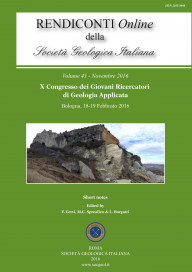
Comparison of different approaches for landslide-induced damage assessment: the case study of Agnone (southern Italy)
Matteo Del Soldato(a,b), Diego Di Martire(a) & Roberto Tomàs(c)
(a) Department of Earth Sciences, Environment and Resources, Federico II University of Napoli, Largo San Marcellino. E-mail: matteo.delsoldato@unina.it
(b) Department of Earth Sciences, University of Firenze, Via La Pira 4, 50121 Florence, Italy
(c) Departamento de Ingeniería Civil, University of Alicante P.O. Box 99, E-03080 Alicante, Spain
DOI: https://doi.org/10.3301/ROL.2016.113
Volume: 41/2016
Pages: 139-142
Abstract
Landslides constitute one of the most important geo-hazards affecting southern Italy. Particularly, in this area slope movements have over time caused relevant socio-economic losses and, in some cases, also casualties. Prevention, prediction and monitoring of landslide phenomena play a key-role to avoid or minimize their effects. In this work, damage suffered by facilities located within and surrounding a deep-seated landslide were classified through three different approaches. The investigated area is located in the municipality of Agnone (Molise region, central-south Italy), which is strongly affected by landslide processes. A main landslide event that occurred in 2003 is still active, exhibiting slow and intermittent movements. In this contribution, three different approaches for landslide-induced damage assessment are compared and their discrepancy discussed, highlighting the benefits and drawbacks of the different approaches. Finally, the future development of a new methodology and classification for infrastructures damage assessment is evaluated, merging the procedures used in this work.
Keywords
Get Full Text